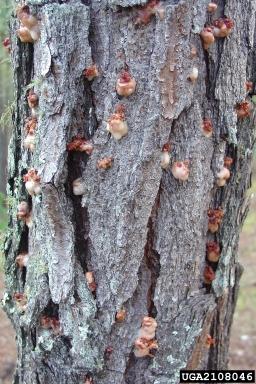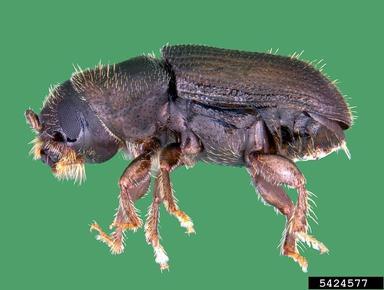Disturbance plays a role in the ecology of the forest ecosystem. Fire, whether natural or manmade, creates early successional habitat leading to a climax community. Other disturbances like wind events, landslides, tree falls and pests act in the same way. These events allow forests to remain dynamic and provide habitat for many woodland flora and fauna. Native species have adapted to these disturbances, including the focus of this article: the Southern Pine Beetle (SPB).
SPB is native to Maryland and the southeastern United States. Since the earliest recorded outbreaks in the 18th century, it has led to widespread destruction. These periodical, concentrated outbreaks can come on fast, decimating pine forests. The disturbances are the result of sheer numbers of beetles, its life cycle, and the particular forest conditions. The SPB’s trees of choice are yellow pines such as the loblolly, Virginia, and pitch pines, as well as longleaf pines and slash pines. The average yearly tree mortality in the U.S. can surpass 30 million cubic feet of pulpwood and 100 million board feet of sawtimber. From 1999 to 2002, outbreaks in the eastern U.S. caused approximately $1 billion in timber losses.
With those numbers, one would think this pine beetle must be huge. In fact, they are very tiny, only 3 mm in length. This aggressive little insect lives mainly in the inner bark of the pines. Entry holes in the bark and, often, resinous masses on the bark called “pitch tubes,” are signs that SPB are present. The female pine beetle’s pheromones and the smell of resin from the trees attracts males. The beetles mate and create S-shaped galleries under the bark to deposit their eggs. The larvae then feed on inner phloem of the tree. Entering the pupae stage, larvae tunnel to the outer bark. The immature adults emerge and their bodies harden and darken. Finally, the beetles create an exit tunnel through the outer bark and fly to another tree to continue the attack.

As the female SPB travels within the pine tree, she leaves behind a blue-stain fungus. This fungus grows in the sapwood and provides food for the developing larvae. This fungus also blocks the circulatory system of the tree, thus hastening the tree’s demise.
Management of this native beetle consists of a variety of elements. Forest managers use integrated pest management to reduce SPB population, frequency, duration, and impacts. First, managers assess a forest stand’s susceptibility across large landscapes. By understanding how vulnerable the trees are, land managers can work effectively in minimizing the damage. These assessments are made using aerial and on foot detection surveys. These surveys look for host pine species, the quality of the sites, the age structure of the forest stand, basal area or stem density, growth rates, and proportion of pine in the overstory.
With this information, managers can choose from a variety of management practices to reduce SPB’s impacts, such as salvage cut, cut & leave, pile & burn, cut & chemically treat. These are followed by suppression efforts, which rely primarily on the removal of infested and nearby trees. Manager create a tree buffer in front of infestations during the growing season by removing uninfected trees ahead of the SPB’s predicted trajectory. This creates a gap between the infected trees and the uninfected trees that are in the beetles’ path. This inhibits the scent of the trees and any other chemical messages that the beetle may have sent out. Disrupting pheromone signals can help confuse SPBs and suppress population growth. Lastly, the land manager may consider restoring pine stands. Restoration efforts include planting less susceptible species, such as longleaf pine.
The Maryland DNR Forest Service monitors many forest pests, including SPB. Current assessments note that counties in Southern Maryland and along the southern Eastern Shore are at some risk of southern pine beetle outbreaks. In order to assess this risk, DNR staff survey loblolly forests in these counties during a six-week period in the spring for SPB.
In the meantime, landowners and managers, and those who enjoy woodlands, can be on the lookout for signs of SPB. Look for vulnerable pines, pitch tubes and blue stain in the pines you harvest. If you do suspect a Southern Pine beetle presence, contact the Maryland Department of Agriculture’s Forest Pest Management Section at fpm.mda@maryland.gov, or call 410-841-5870.
